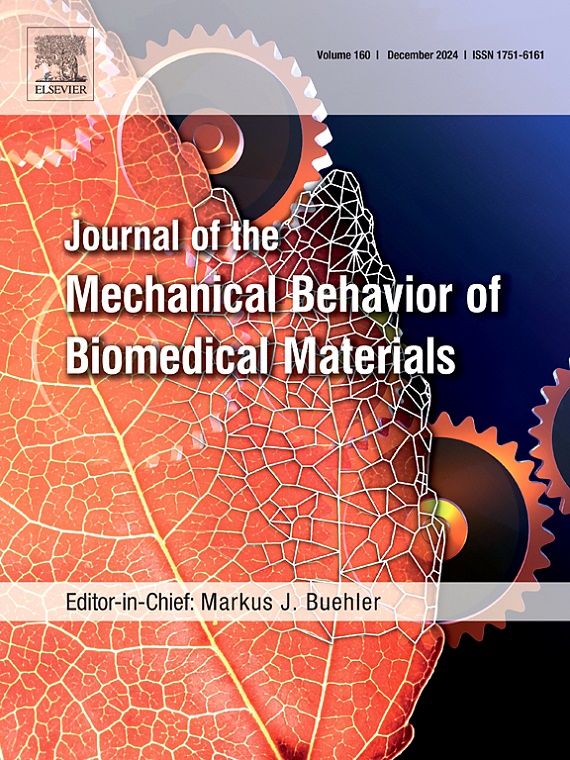超高分子量聚乙烯固态复合材料的韧性测定
IF 3.5
2区 医学
Q2 ENGINEERING, BIOMEDICAL
Journal of the Mechanical Behavior of Biomedical Materials
Pub Date : 2025-07-12
DOI:10.1016/j.jmbbm.2025.107136
引用次数: 0
摘要
超高分子量聚乙烯(UHMWPE)固态复合材料在关节置换术中越来越多地用于各种治疗和传感用例。由于其极高的熔体粘度,超高分子量聚乙烯复合材料表现出比低粘度聚合物复合材料更明显的相偏析。这种相偏析可能以不同于先前研究的微观结构因素(例如交联)的方式影响超高分子量聚乙烯的行为。本研究的目的是通过几种不同的测量方法来量化超高分子量聚乙烯纳米复合材料在一系列炭黑(CB)填料负载下的抗破坏能力。结果表明,与纯对照相比,低填料浓度下拉伸韧性和冲击韧性保持或增加,高填料含量下拉伸韧性和冲击韧性下降。另一方面,疲劳裂纹扩展抗力(CPR)在较低浓度下表现出与拉伸韧性和冲击韧性相似的行为,但在较高浓度下表现出不同的行为。从2.5 wt% CB到测试的最高浓度(10 wt% CB),疲劳性能得到改善-与拉伸或冲击韧性不同。随着填料含量的增加,观察到的宏观行为转变与通过扫描电子显微镜(SEM)和断口表面成像观察到的微观结构现象相吻合。这些现象包括从穿晶断裂到沿晶断裂的转变,完全的颗粒包覆的开始,以及晶间空隙的形成。这项工作表明,拉伸和冲击韧性不一定表明这些材料的疲劳CPR。总的来说,本研究的发现激发了相分离聚合物复合材料结构-性能关系的进一步研究,并展示了其在高负载情况下的应用前景。本文章由计算机程序翻译,如有差异,请以英文原文为准。
Toughness measures in solid-state composites of ultra-high molecular weight polyethylene
Solid-state composites of ultra-high molecular weight polyethylene (UHMWPE) are increasingly being investigated for various therapeutic and sensing use cases in arthroplasty. Due to its extremely high melt viscosity, composites of UHMWPE exhibit a much more distinct phase segregation than lower-viscosity polymer composites. This phase segregation may influence UHMWPE behavior in a different way than microstructural factors studied previously (e.g. crosslinking). The purpose of this study was to quantify UHMWPE nanocomposites’ resistance to failure via several distinct measures, across a range of carbon black (CB) filler loadings. Results showed that tensile and impact toughness followed similar trends: both maintained or increased in magnitude over neat controls at low filler concentration, then decreased at higher filler contents. On the other hand, fatigue crack propagation resistance (CPR) demonstrated similar behavior to tensile and impact toughness at lower concentrations but diverged at higher concentrations. From 2.5 wt% CB to the highest concentration tested (10 wt% CB), fatigue properties improved—unlike tensile or impact toughness. The observed transitions in macroscopic behavior with increasing filler content coincided with microstructural phenomena observed via scanning electron microscopy (SEM) and fracture surface imaging. These phenomena included a transition from transgranular fracture to intergranular fracture, the onset of complete granule coating, and the formation of intergranular voids. This work demonstrates that tensile and impact toughness are not necessarily indicative of fatigue CPR in these materials. Broadly, the findings presented in this study motivate further investigation of structure-property relationships for phase-segregated polymer composites and demonstrate promise for their use in high-load scenarios.
求助全文
通过发布文献求助,成功后即可免费获取论文全文。
去求助
来源期刊

Journal of the Mechanical Behavior of Biomedical Materials
工程技术-材料科学:生物材料
CiteScore
7.20
自引率
7.70%
发文量
505
审稿时长
46 days
期刊介绍:
The Journal of the Mechanical Behavior of Biomedical Materials is concerned with the mechanical deformation, damage and failure under applied forces, of biological material (at the tissue, cellular and molecular levels) and of biomaterials, i.e. those materials which are designed to mimic or replace biological materials.
The primary focus of the journal is the synthesis of materials science, biology, and medical and dental science. Reports of fundamental scientific investigations are welcome, as are articles concerned with the practical application of materials in medical devices. Both experimental and theoretical work is of interest; theoretical papers will normally include comparison of predictions with experimental data, though we recognize that this may not always be appropriate. The journal also publishes technical notes concerned with emerging experimental or theoretical techniques, letters to the editor and, by invitation, review articles and papers describing existing techniques for the benefit of an interdisciplinary readership.
 求助内容:
求助内容: 应助结果提醒方式:
应助结果提醒方式:


